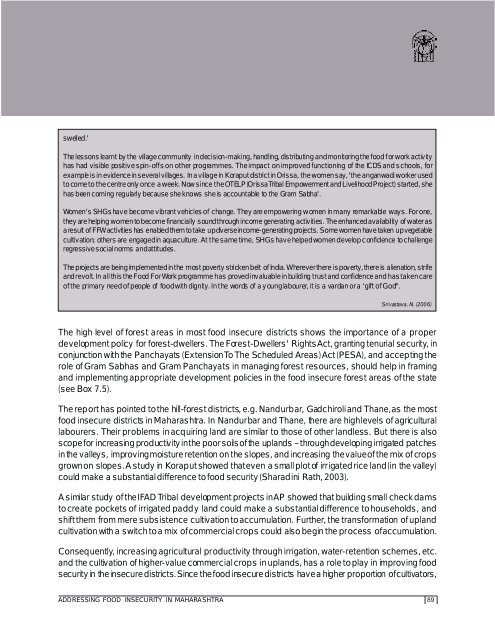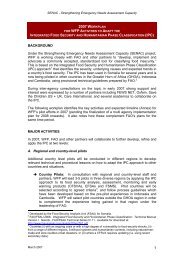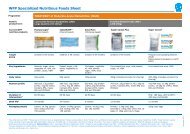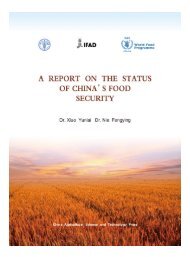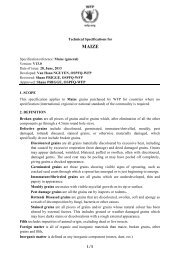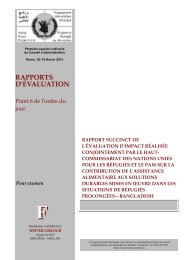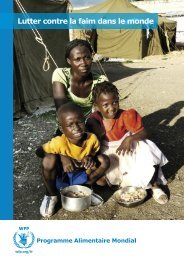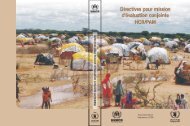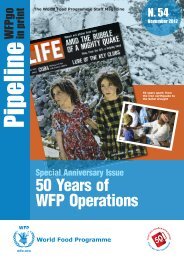Food Security Atlas Of RURAL MAHARASHTRA - WFP Remote ...
Food Security Atlas Of RURAL MAHARASHTRA - WFP Remote ...
Food Security Atlas Of RURAL MAHARASHTRA - WFP Remote ...
You also want an ePaper? Increase the reach of your titles
YUMPU automatically turns print PDFs into web optimized ePapers that Google loves.
swelled.'The lessons learnt by the village community in decision-making, handling, distributing and monitoring the food for work activityhas had visible positive spin-offs on other programmes. The impact on improved functioning of the ICDS and schools, forexample is in evidence in several villages. In a village in Koraput district in Orissa, the women say, 'the anganwadi worker usedto come to the centre only once a week. Now since the OTELP (Orissa Tribal Empowerment and Livelihood Project) started, shehas been coming regularly because she knows she is accountable to the Gram Sabha'.Women's SHGs have become vibrant vehicles of change. They are empowering women in many remarkable ways. For one,they are helping women to become financially sound through income generating activities. The enhanced availability of water asa result of FFW activities has enabled them to take up diverse income-generating projects. Some women have taken up vegetablecultivation; others are engaged in aquaculture. At the same time, SHGs have helped women develop confidence to challengeregressive social norms and attitudes.The projects are being implemented in the most poverty stricken belt of India. Wherever there is poverty, there is alienation, strifeand revolt. In all this the <strong>Food</strong> For Work programme has proved invaluable in building trust and confidence and has taken careof the primary need of people of food with dignity. In the words of a young labourer, it is a vardan or a 'gift of God".Srivastava, N. (2006)The high level of forest areas in most food insecure districts shows the importance of a properdevelopment policy for forest-dwellers. The Forest-Dwellers' Rights Act, granting tenurial security, inconjunction with the Panchayats (Extension To The Scheduled Areas) Act (PESA), and accepting therole of Gram Sabhas and Gram Panchayats in managing forest resources, should help in framingand implementing appropriate development policies in the food insecure forest areas of the state(see Box 7.5).The report has pointed to the hill-forest districts, e.g. Nandurbar, Gadchiroli and Thane, as the mostfood insecure districts in Maharashtra. In Nandurbar and Thane, there are high levels of agriculturallabourers. Their problems in acquiring land are similar to those of other landless. But there is alsoscope for increasing productivity in the poor soils of the uplands – through developing irrigated patchesin the valleys, improving moisture retention on the slopes, and increasing the value of the mix of cropsgrown on slopes. A study in Koraput showed that even a small plot of irrigated rice land (in the valley)could make a substantial difference to food security (Sharadini Rath, 2003).A similar study of the IFAD Tribal development projects in AP showed that building small check damsto create pockets of irrigated paddy land could make a substantial difference to households, andshift them from mere subsistence cultivation to accumulation. Further, the transformation of uplandcultivation with a switch to a mix of commercial crops could also begin the process of accumulation.Consequently, increasing agricultural productivity through irrigation, water-retention schemes, etc.and the cultivation of higher-value commercial crops in uplands, has a role to play in improving foodsecurity in the insecure districts. Since the food insecure districts have a higher proportion of cultivators,ADDRESSING FOOD INSECURITY IN <strong>MAHARASHTRA</strong>89


